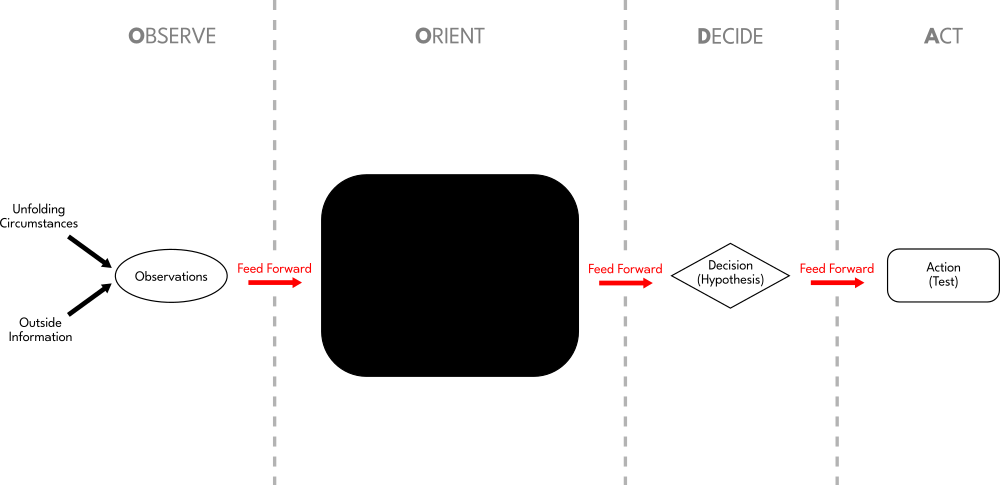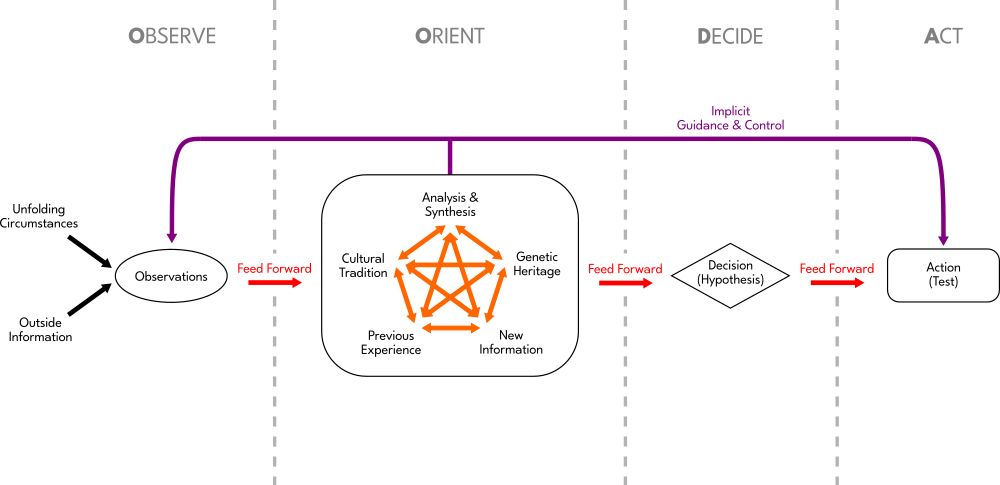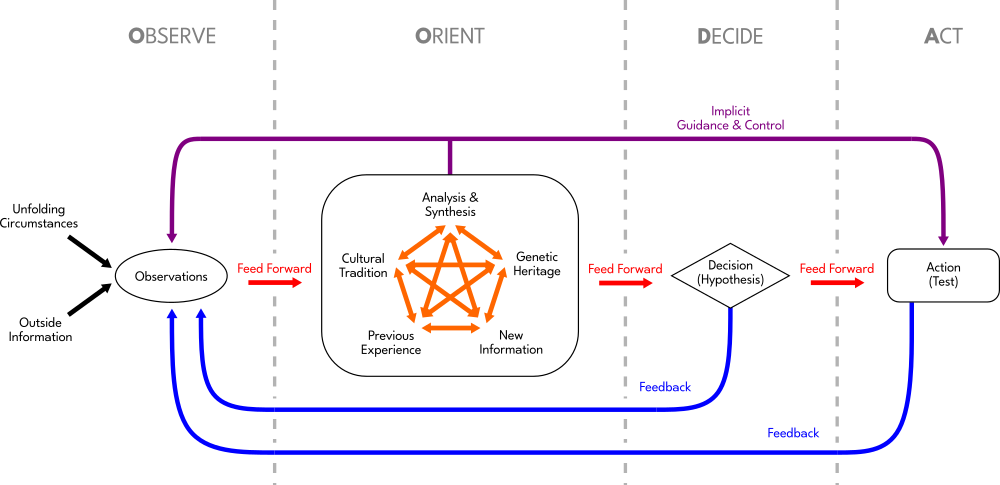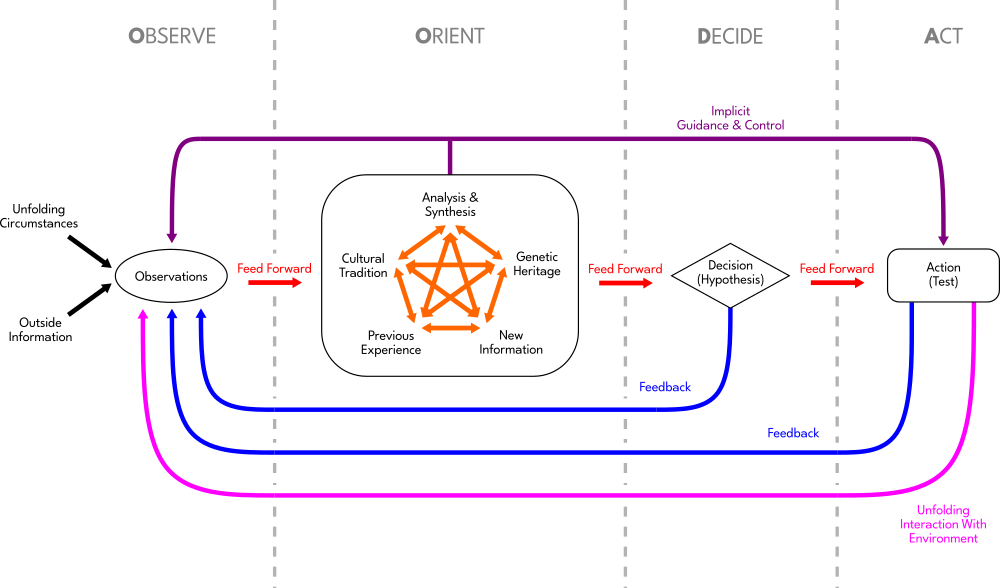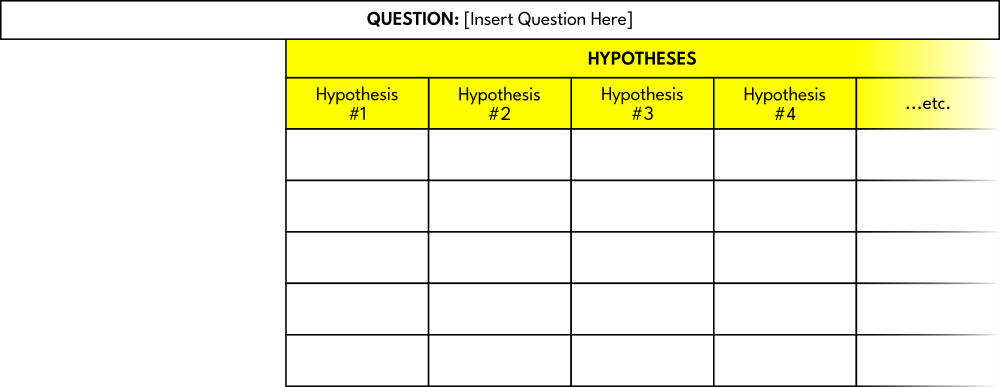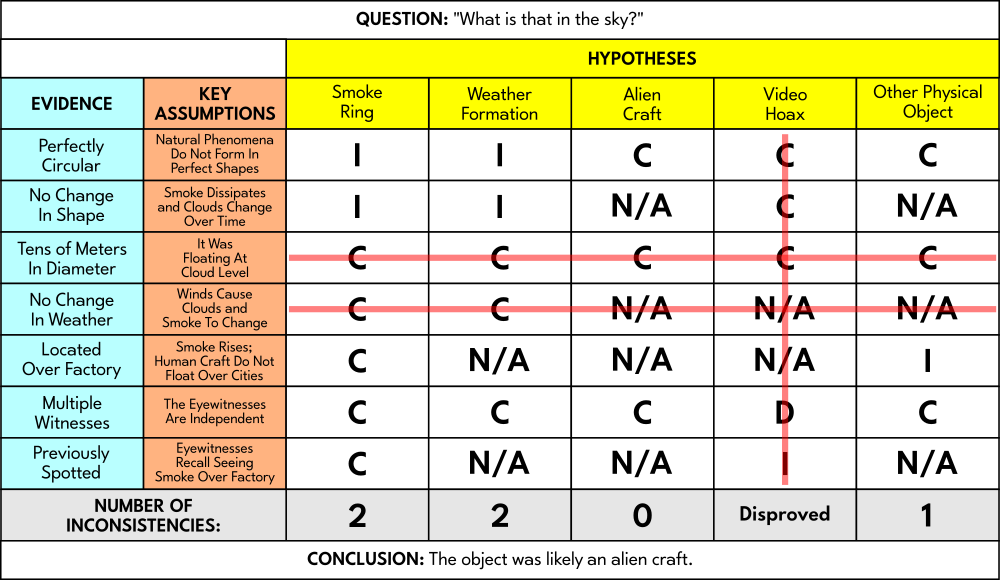Back • Return Home
Handling Complexity
Sometimes systems are "complex". They have a lot of "moving parts" and there is ambiguity about how they interrelate. This might even produce a sense of "burnout" as we try to interact with them. Both the military and intelligence communities have some interesting tools for handling complex situations. Instead of applying them in destructive ways (e.g.: towards war strategy, creation of propaganda, etc.), we can direct them towards creating personal calm and interpersonal peace. Let's explore a couple of these tools together...
The OODA Loop
The first one that we will cover is known as The OODA Loop, which was formulated by an interesting character by the name of John Boyd. It is essentially an outline of the decision-making process.
"OODA" is an acronym that means:
• Observe - Take in all available data about a changing circumstance
• Orient - Assess that data and understand how one relates to it
• Decide - Formulate an idea about how it works and choose how to respond to it
• Act - Carry out the decision and gain new information from that experience
We will represent each of these as a series of icons ordered from left-to-right:
Each icon is a stage in The OODA Loop. They are interconnected by red arrows marked "Feed Forward". "Feed Foward" is when a system transfers information from one layer of a process to another in anticipation of any new information. Observations can be uncertain. In other words, The OODA Loop is both predictive and adaptive. Because we are interpreting a changing circumstance, we might need to respond or redirect before something else occurs in order for the situation to stay manageable.
The rate at which a person goes through the stages in an The OODA Loop is called their "Tempo". It can be done relatively quickly or slowly. Note that "fast" is not always better, nor is "slow" always possible. Different situations require different Tempos. When dealing with uncertainty, we need to be able to reliably predict and to carefully adapt. How do we do this?
Let's explore what is inside of that black box in the Orient step:
We never approach a situation as a "blank slate". There are all sorts of factors that play a role in both what we observe and what we are capable of doing. For example:
• Genetic Heritage
• Cultural Traditions
• Past Experience
We compare the above aspects to New Information, taking note of where they are the same and where they are different. In addition to any fear of the unknown, it may cause stress if there is a significant mismatch between the two. This is referred to as "Cognitive Dissonance" (i.e.: anxiety caused by holding two or more seemingly conflicting ideas in mind simultaneously). Rather than become overwhelmed and ignoring potentially important information, we can regain a sense of stability by trying to find a way to reconcile whatever constructive qualities each aspect might contain.
Analysis is to take apart, whereas Synthesis is to put together. We can use these to rearrange all of the above in order to make a model of reality that is useful. This process is represented by the orange arrows within the above diagram. Boyd refers to this as "Snowmobiling". A snowmobile is a mix of different ideas that are combined in such a way as to make a functional vehicle:
the outboard motor of a motorboat + the treads of a tank + the handlebars of a bike + skis
The Orient step is creative. It requires us to make associations across many different types of information. What model of reality will work best to carry us towards our goal? What resources do we have at our disposal and how can we use them effectively? We need to challenge our assumptions and stay flexible in our point of view.
The "Scientific Method" is naturally part of The OODA Loop. Notice how the Decide and Act steps contain the words "Hypothesis" and "Test" in parentheses. However, The OODA Loop also accounts for the unique qualities of the observer! Again, there are pre-existing factors that influence both what we observe and what we are capable of doing, even within the context of science. This is represented in the above diagram by the purple arrows marked "Implicit Guidance & Control".
Let's extend the diagram again:
Now we have added a couple of blue arrows that are marked "Feedback". "Feedback" is when the output of one layer of a system becomes the input for another. There are two different types of feedback. "Positive feedback" is when it leads to something being reinforced. "Negative feedback" is when it leads to something being dampened out. A "feedback loop" is when this happens repeatedly. Positive and negative feedback loops occur all throughout Nature, including within the human body.
Notice that the Decide and Act steps of The OODA Loop connect back to the Observe step. The results of these steps can affect what is Observed in a way that is cyclical and compounds upon itself. This can be either "good" or "bad" depending upon how this feedback is directed. One thing to watch out for is "The Incestuous Amplification Effect".
The Incestuous Amplification Effect creates a condition that makes it impossible for important information to enter into The OODA Loop. Nothing can be corrected, so the likelihood of misinterpretation increases (or is "amplified"). It has three components to it:
1. Selective Exposure - minimizing exposure to ideas that run contrary to one's own beliefs
2. Selective Perception - refusing to recognize information that contradicts those beliefs
3. Selective Recall - only remembering things that support one's viewpoints and forgetting the rest
Sometimes the term "Confirmation Bias" is used to describe this type of behavior (i.e.: only accepting information which confirms one's biases). We need to consider all aspects, not only those that we favor, and look beyond what is readily visible. Be careful with labels and any stereotypes that they might evoke!
Let's extend the diagram one last time:
In the same way that the blue arrows create nested feedback loops that affect every aspect of the cycle, The OODA Loop as a whole exists within a larger context in both time and space. This is represented by the magenta arrow marked "Unfolding Interaction With Environment".
We have already mentioned how one can change their Tempo through The OODA Loop. Similarly, there are also OODA Loops that operate at different time scales (i.e.: short-term and long-term goals).
Likewise, OODA Loops interact and overlap. Decisions are never made in a vacuum. They always affect other people, and might even be made with other people in groups of varying sizes. Boyd points out things which help The OODA Loops within ourselves and other people to mesh:
1. Intuitive Skill - We increase our ability to handle uncertainty by building up constructive habits. We can recognize important information more quickly when it is familiar, and when they are made into a reflex, skills can be carried out more creatively because they are less difficult to do.
2. Mutual Trust - When working with others, we need both shared values and teamwork. If we work together instead of against one another, and can trust that each will do what they say, then we can get more done with less worry or fighting.
3. Focus - After we have taken in as much information as possible and carefully reasoned about our options, we need to formulate a clear strategy to reach our goals. If it is a shared goal, then each needs to emphasize what is important to them while staying flexible about specific details. Do not limit the constructive ways in which it can be achieved. Each has their own awareness and skills that can contribute.
Please keep in mind that The Incestuous Amplification Effect can appear not only within the individual, but also collectively! This can create a social environment that feeds into particular beliefs (i.e.: an "Echo Chamber"), and situations in which people blindly follow or succumb to peer pressure. This goes by various names, such as "Groupthink", "Herd Mentality", etc.
[If you are interested in learning more about The OODA Loop, see the free articles "OODA: How To Turn Uncertainty Into Opportunity" by Taylor Pearson, "OO-OO-OO! The Sound of a Broken OODA Loop" by David G. Ullman, and of course, John Boyd's original writings. Warning: While these are interesting and have many useful concepts, all of them have either a warfare or a competitive corporate culture "flavor" to them. We tried to summarize the essentials above without using such terminology. Again, we want to emphasize that these tools should be used to help, not harm one another!]
The ACH Matrix
The next tool that we will cover is The ACH Matrix. "ACH" is an acronym that means "Analysis of Competing Hypotheses". Sometimes more than one explanation of a situation seems possible and we need some help narrowing them down. This is where The ACH Matrix comes in! [Howcast used to have a wonderful video that broke down the steps for making an ACH Matrix. The following instructions are based on it.]
Step 1: Gather all of the necessary information. This includes...
• A closed-ended question about what is happening
This is a question that has a single answer that is definite and unchanging. It is distinct from an "open-ended question" that may be vague or focus in on opinions.
• A list of plausible hypotheses
A hypothesis is simply an educated guess as to why something is happening. This list should be "collectively exhaustive" and "mutually exclusive". In other words, these hypotheses must encompass every possibility and there should be no overlap between them. This increases the likelihood that one of them will be the answer to the question.
• All available evidence
Do not "Cherry Pick" (i.e.: only select evidence that validates what one already assumes to be true about the situation). Also, consider evidence that one might not be able to get ahold of but still potentially exists.
There is no set number of hypotheses or pieces of evidence that one must have. This will change depending upon the situation.
Step 2: Write out the question. This will be the title of a table.
Step 3: Put each hypothesis at the top of its own column. The number of columns within the table will be the number of hypotheses.
Step 4: Create a separate row for each piece of evidence. It might be helpful to create an extra column for any key assumptions implied by each piece of evidence.
Step 5: Notice that every column crosses every row. This relates each hypothesis to each piece of evidence. We now have an ACH Matrix for our question! In order to use it, carefully fill in every cell of the table with one of the following letters based upon whether that piece of evidence supports, refutes, or disproves each hypothesis...
• "C" = Consistent
The evidence supports that hypothesis directly or is possible within the context of that hypothesis
• "I" = Inconsistent
The evidence refutes that hypothesis (i.e.: goes counter to it without necessarily disproving it)
• "D" = Disproves
The evidence is irrefutable and completely negates the possibility of that hypothesis
• "N/A" = Not Applicable
The evidence is not relevant to that hypothesis; it is neither Consistent, nor Inconsistent
Step 6: Cross out any column(s) that are thoroughly disproven.
Step 7: Cross out any row(s) that are "non-diagnostic" (i.e.: contain evidence that is not applicable to any hypothesis or is equally consistent with all hypotheses, and therefore, doesn't give any useful information to distinguish them).
Step 8: Tally up the number of C's and I's for each column. These totals will help us to order every hypothesis from "least likely" to "most likely". The fewer the number of I's for that column, the more likely that hypothesis. If two or more columns have the same number of I's, then the hypotheses are not mutually exclusive or we need to gather more evidence in order to distinguish them. Focus in on the hypotheses that are the most consistent with the evidence (i.e.: the columns where the number of C's is greater than the number of I's), not necessarily the columns that are the most likely. Not all inconsistences are necessarily of equal importance.
Step 9: Question assumptions and revise the table as more information comes in. Hypotheses that were unlikely/disproven and evidence that was non-diagnostic may take on new meaning. Likewise, new hypotheses may present themselves or some old evidence may prove unreliable. Pride sometimes keeps people from reconsidering choices that they have made previously, but it is okay to change your point of view as you learn more! This is a natural part of the learning process.
Here is an example ACH Matrix [as given within the Howcast video]:
Notice that the conclusion (i.e.: the existence of an alien craft) might seem outrageous. Never let the topic or outcome discourage you from considering the facts! Just because something seems implausible does not mean that it is impossible. Likewise, situations that might seem alike on their surface can be very different from one another sometimes. This is why we focus in on consistency rather than likelihood. [In this case, the smoke ring hypothesis is more consistent even if it is less likely. Therefore, the conclusion is probably false. We need more data!]
If you are facing some complex situation, try using The OODA Loop and The ACH Matrix together. The ACH Matrix is particularly helpful during the Decide step of The OODA Loop when we have some time to reflect before acting or testing.
[This is a broad overview. There is a little bit of variation in how one can approach the ratings within each cell and the totals of each column. For a more in-depth look at The ACH Matrix, see the free video "Intelligence Analysis Skills: Analysis of Competing Hypotheses" by Brian R. Urlacher. As Brian points out, The ACH Matrix is actually part of a larger class of methods called "Structured Analytic Techniques". If you're interested, be sure to check out the "Tradecraft Primer" PDF given within the previous link.]
Other Tools
Not every organization is cleanly divided into one purpose or activity. Both the military and intelligence communities make use of think tanks, private consulting firms, and other research groups to try to understand various situations. One of these groups is known as Idiagram, whose members have put together a useful presentation on solving complex problems. They have applied this method to several interesting projects as well.
The closer we look, the more that we can see these types of tools being used all throughout governments, businesses, academic institutions, and other groups of people. The question is: "To what end?"
A method can be powerful, but if it is used in a destructive way, then it is worse than useless. This is true whether it is applied by one person or many people. Thankfully, we can use these tools towards everyone's benefit (i.e.: both ourselves and everyone else simultaneously).
We hope that this article was and will continue to be helpful to you. Thank you for reading!
[...And special thanks to goblin-heart for the link to the Untools website!]
